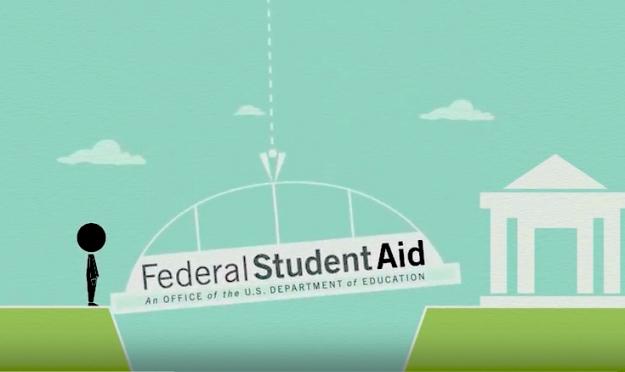How digital design helped recast Education Department’s FAFSA and College Scorecard tools

For millions of Americans, the road to a higher education — and a slice of $180 billion in federal financial aid each year— begins at a federal government website known as FAFSA.
The White House and the U.S. Department of Education’s announced late last week that the Obama administration is taking new steps to make passing through that site easier.
Completing the government’s Free Application for Federal Student Aid form has long been the bane of college-bound students and their families who every January were required to fill out a lengthy form, including their prior year’s federal income tax return information. They also had to submit estimated figures for their upcoming returns, then resubmit the form a second time a few months later with actual figures.
The administration said it is streamlining the process by making the FAFSA form available three months earlier — on October 1 instead of January 1—and also making it easier to populate the form just once a year, using an IRS data retrieval tool.
The changes are expected to save students and families “well over half a million hours in paperwork” and allow schools to “transfer 3 million [work] hours from verifying information to advising students and making financial aid awards,” according to a White House fact sheet.
User-centric design
The changes are victory for common sense and the better use of technology.
But they also reflect a broader push by the Obama administration to reengineer the way federal agencies engage with the public electronically — and the growing behind-the-scenes influence of the United States Digital Service, a digital design SWAT team the White House launched two years ago.
The U.S. Digital Service was created to help federal agencies walk in the virtual shoes of their customers and then move quickly to redesign the digital delivery and underlying workflow of some of the government’s most important services.
For the Department of Education, that design approach took root about a year ago with the rollout of a new College Scorecard.
Just as federal government captures terabytes of weather data daily and makes it available to commercial weather services and eventually the weather apps on our smartphones, the Education Department wanted to take the reams of data it collects on the cost of education, graduation rates, student debt, post-college earnings and more, and make it more useful to students as they think about their college investment plans.
The initial College Scorecard, launched in August 2013 “was a pretty modest success,” recalls Clare McCann, senior policy advisor at the Department of Education. It had lots of data and some useful tools, but like many government websites, had been largely designed from the inside out.
The department planned to upgrade the scorecard for a re-launch in the fall of 2015, but took a step back when USDS and 18F, a technology specialty team within the government’s General Services Administration, became available to help.
“We only had a couple of months to build a whole new site, to understand the data and the audience,” McCann said in an interview with EdScoop. “We took to the streets and did a bunch of user testing, with mockups of what the site looked like, and at what data would be most relevant,” she said.
The new College Scorecard website the department released not only made it easier for students to evaluate thousands of schools based on affordability, size, and post-degree earnings potential, it also made it easier for developers to use as well.
Focus on front and back ends
In addition to designing the front-end user experience “from scratch,” McCann said USDS also helped create APIs — programming interfaces developers can use. That makes it easier to stream 20 years of Education Department data into the back-ends of other popular online college advising services, such as CollegeAbacus, ScholarMatcher and Schoold.
“It’s all open source, and all changes are maintained on GitHub,” she said, referring to the web-based platform for managing and distributing open source code features that has become widely adopted by government website developers.
“The API is magical compared to the old spreadsheets,” said Abigail Seldin, vice president of innovation at ECMC Group and cofounder of CollegeAbacus and Pell Abacus. “We’ve seen an increasing emphasis on open data — it’s been a tremendous boon for the American public,” she told EdScoop.
That was all the more evident when the Department of Education refreshed the site September 14 with another year’s worth a data. The department said the College Scorecard now includes 1,700 data points for more than 7,000 institutions of higher education.
But that data is also evident in basic online searches, according to Google’s Susie DePianto, senior program manager for education research, who highlighted in a blog Friday how Google is featuring College Scorecard data online.
While McCann said that the USDS and 18F have since moved on, and the Education Department now relies on a contractor to maintain the College Scorecard, their design principles continue to guide the department’s efforts.
One example is the launch of StudentLoans.gov/Repay, a mobile-first application designed to help more than 40 million Americans manage their student loan debt. The app asks borrowers five simple questions to guide them more quickly through what remains a complex set of student loan repayment options, according to McCann.
And next year, the Education Department plans to link FAFSA with the College Scorecard, according to McCann. The goal is to help students can make more informed choices about their college investment, by weighing personalized financial aid estimates against the kind of career and financial outcomes associated with the schools they’re considering.
Altogether, the Obama administration said in its announcement last week that it will have new commitments from over 170 organizations this year to share information about the FAFSA and the College Scorecard and likely reach 20 million additional students this year. It also pointed to the expanded use of tools, like Up Next’s texting tool, that lets students get step-by-step advice and personalized support from College Advising Corps, College Forward, College Possible, and Inside Track counselors to guide students through the FAFSA form and their options for repaying their loans after graduation.
Winning the public’s notice
Few expect the design changes to eliminate the pain of applying for federal aid or prevent students from getting overwhelmed by all the College Scorecard has to offer.
“The recent change on the FAFSA submission deadline is a positive step in the right direction,” however, said Francesca Purcell, director of the American Academy of Arts and Sciences Commission on the Future of Undergraduate Education.
“In general, college pricing and student aid systems are unnecessarily complex and difficult for students and families to understand and navigate, with institutions providing a mysterious array of discounts and the federal student aid system requiring a burdensome application process,” Purcell said. “Thus, efforts by the federal government to make information about prices, aid, and outcomes more accessible and transparent is very welcome and necessary,” she said.
Whether the public fully recognizes the design changes is still to be determined, although the demand for helpful digital tools to support college-bound students remains high.
An August poll by Accenture Federal Services found that three in four citizens expressed interest in the federal government offering a “financial aid” tool to help college students manage applications and debt repayment, apparently unaware that government already offers such a tool.
That could be in part, suggested McCann, because students often don’t recognize the college resource websites they’re using actually rely heavily on data supplied by the Education Department.
Anthony Pinheiro, a managing director for Accenture Federal Services, acknowledged tools such as the College Scorecard and StudentAid.ed.gov are valuable, but added “the task of supporting students through digital innovation should not fall exclusively to government.”



